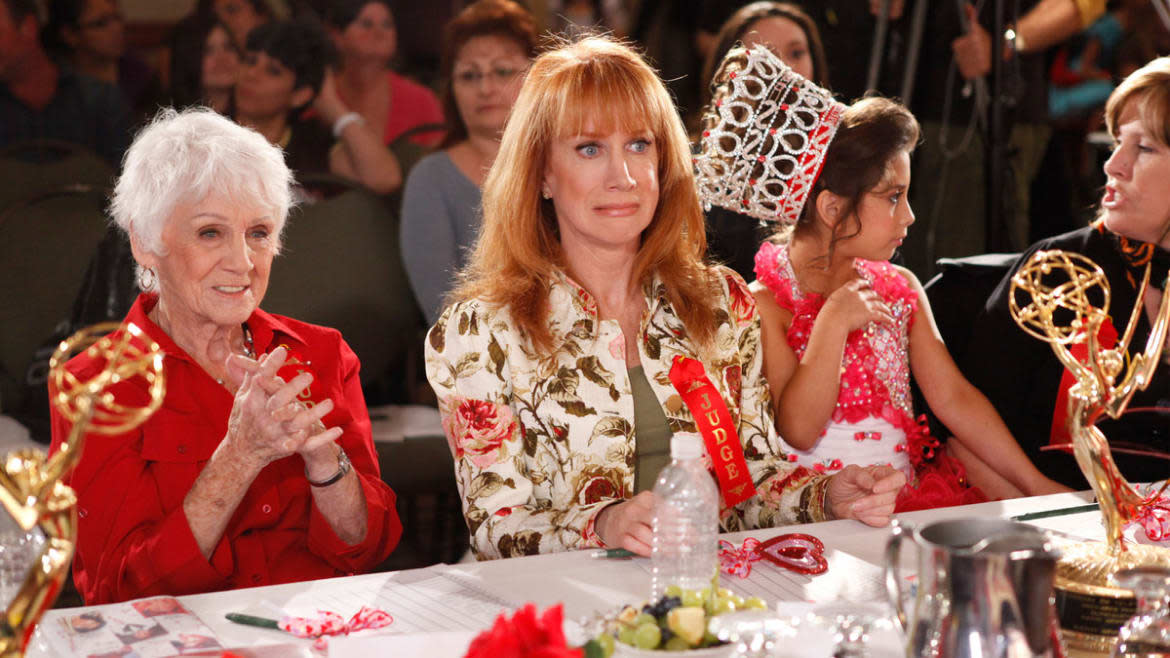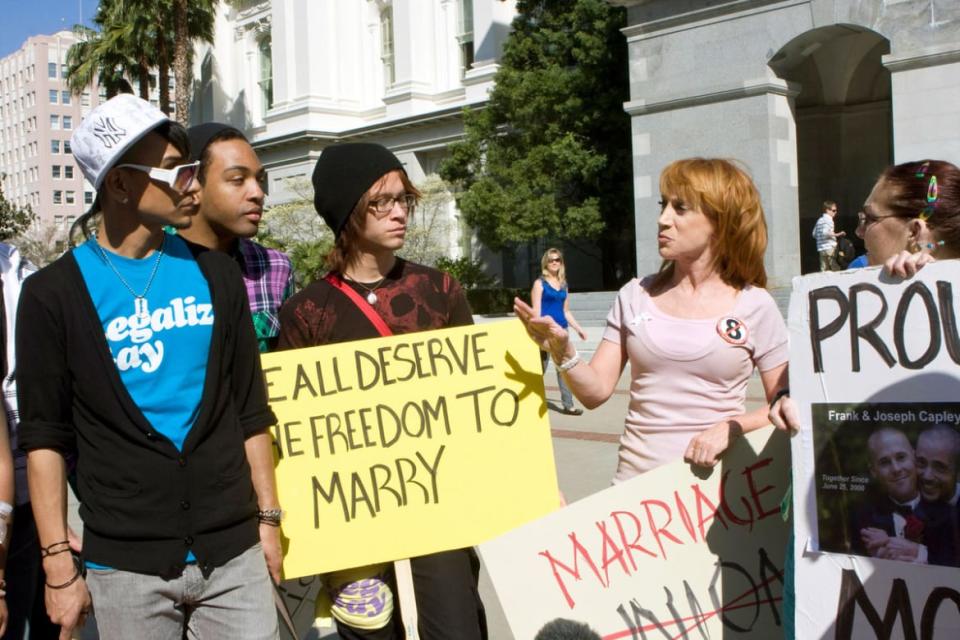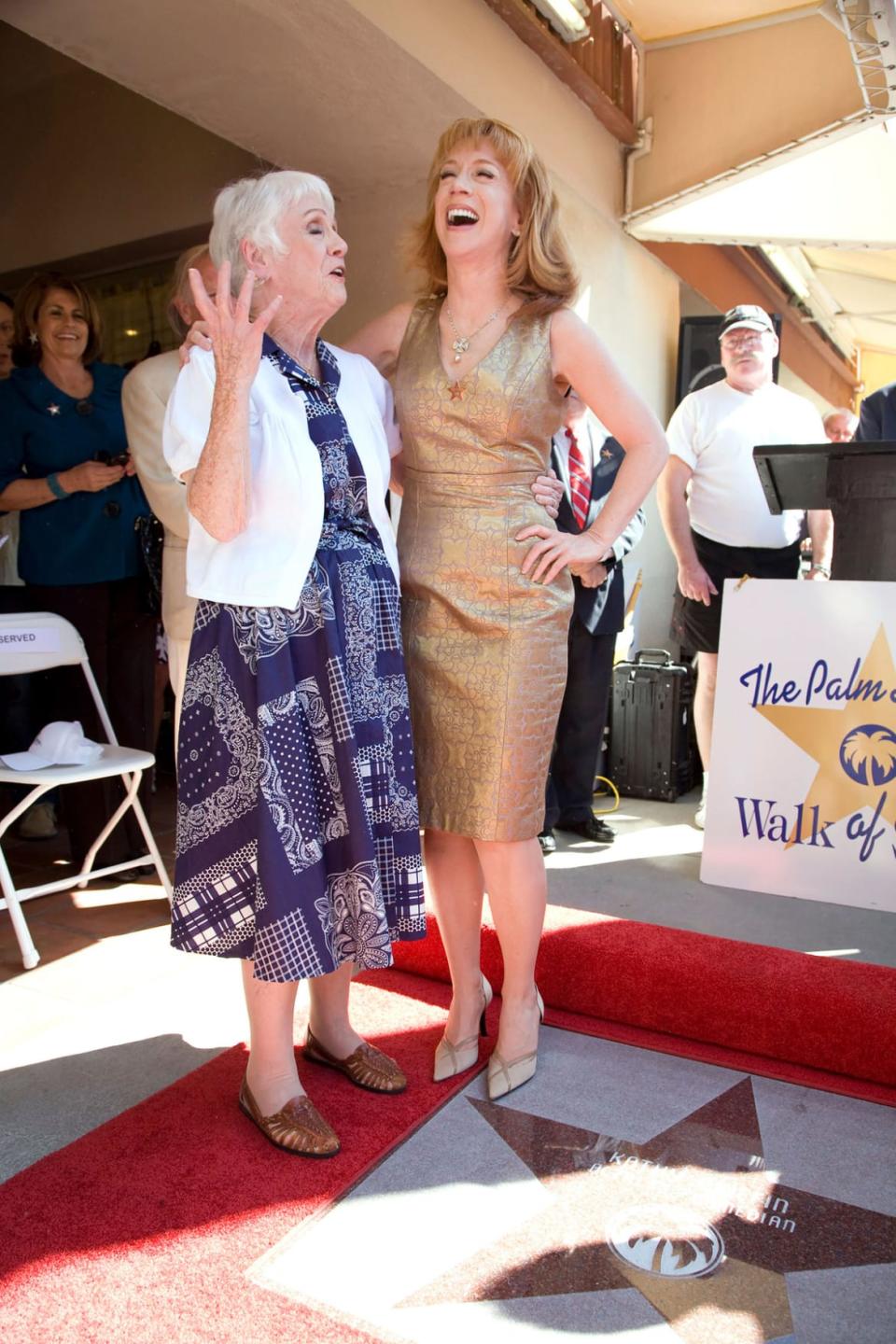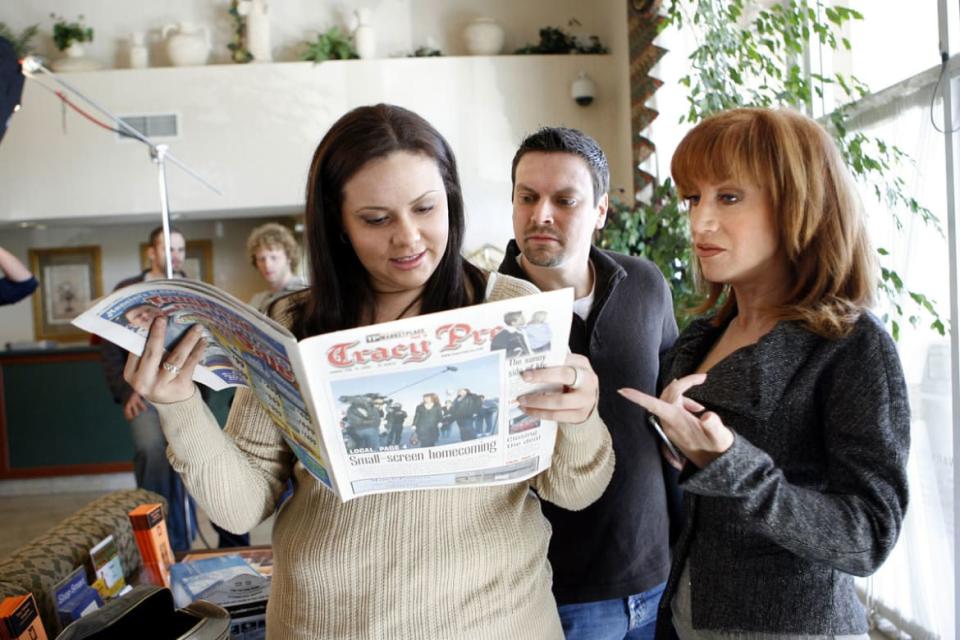There’ll Never Be Another Show Like Kathy Griffin’s ‘My Life on the D-List’

- Oops!Something went wrong.Please try again later.
The phrase “They don’t make ’em like that anymore” has always bewildered me. In most cases where this adage is applied, people are still making “them” like “that;” it just depends on where you’re looking. But in the case of Kathy Griffin: My Life on the D-List—the crimson-haired comic’s reality show that bowed in 2010 after six stellar seasons—they absolutely do not make them like that anymore.
My Life on the D-List was and is a rarity in the reality television landscape. It blurred the lines between fact, fiction, and fame by putting Griffin in increasingly ridiculous situations as she tried to claw her way to A-List stardom. The unspoken joke of the show was that Griffin was never really as D-List as she claimed to be, but that she said yes to just about any ridiculous gig or opportunity that landed in her lap, much in the way that a D-lister might.
While these engagements were always wildly funny, Griffin’s willingness to treat every gig with the same level of importance allowed the show to swerve into unexpected poignancy. If Griffin weren’t a self-described media whore, her reality show might be more like what we’re used to seeing today: repetitive, mind-numbing grasps at televised celebrity. Instead, watching it now, it’s an enthralling look at how fame has changed. Notoriety is a fleeting thrill that anyone with a phone can experience. But achieving fame and keeping it takes not just talent and drive, but genuine heart, too. Griffin understood how to take shots at her industry without alienating her peers (at least, most of the time), and rewatching her rile up the rich and glamorous today, amid an era of Hollywood toothlessness, is a guilty-pleasure binge-viewing with none of the guilt.

Kathy Griffin talks to pro-gay marriage protesters in a still from ‘Kathy Griffin: My Life on the D-List’
For far too long, My Life on the D-List was not easily accessible. The show, which originally aired on Bravo, had been hacked up into little clips and longer vignettes that were posted on YouTube during its original run. For the majority of the last 14 years, the only place you could watch Griffin’s show in full was on DVD. But last month, a collection of old Bravo shows, including D-List, migrated from television purgatory over to Peacock, giving a new generation the chance to watch Bravo’s best bits of reality gold. (The best part: Griffin recently bought back the rights to the show and all of her other television specials, meaning that this deal likely sets her up with a handsome payday.)
While the world is a better place with easier access to NYC Prep and The Rachel Zoe Project, there is no classic Bravo show superior to My Life on the D-List. What Griffin did with her time on reality television can never be replicated. The series arrived at the exact right time in late 2005, when tabloid culture was about to hit its apex, but slice-of-life reality television was still a relatively new idea. Griffin’s show capitalized on society’s increasing fascination with celebrity and scandal in the burgeoning tech era. At the same time, it allowed viewers into that life, giving them a firsthand glimpse at the fickle inner workings of the entertainment industry, thrust through Griffin’s shrewd lens.
A show like this couldn’t exist today, because, unlike stars of today’s fare, everything Griffin did was authentic and sincere. This was just Griffin’s life and career, on display for anyone who cared to look. Even when D-List adopted a more manufactured rhythm to its episodes as the seasons went on, it was never observably produced, and certainly not to the degree that most modern reality shows are. The closest we’ve gotten to a show like this in recent years are glimpses at Garcelle Beauvais premiering her new Lifetime original movie on Real Housewives of Beverly Hills. No offense to Beauvais, but, needless to say, that lacks the same compelling grit as something like My Life on the D-List.
“We overshot the shit out of it,” Griffin told Vulture about the show’s production, in a profile last year. “It was eight episodes a year, and we would film for six months. They just followed me around and hoped I did funny shit… Good, bad, or indifferent, it was all genuine.” The reality aspect of the series is plain to see in its scrappier first two seasons. As she tries to get the show off the ground, Griffin runs around promoting it and her standup act all over the country, often to strangers mistaking her for Kathie Lee Gifford or not recognizing her at all. Chaos frequently ensues because of how busted her operation is—which is part of the show’s broader charm to its end, but is far more noticeable in Seasons 1 and 2. In one early episode, Griffin is due to host an E! Network red carpet special, but leaves her access badge in her hotel room. The scramble to track down the badge’s whereabouts resembles a Mission: Impossible scene because, of course, she’s not famous enough to get let onto the carpet without security clearance.

Maggie Griffin and Kathy Griffin laugh and hug in a still from ‘Kathy Griffin: My Life on the D-List’
There are plenty of these perfectly executed jokes in My Life on the D-List, but just as many moments that are abruptly heartbreaking. In Season 1, Griffin is a guest on The Tonight Show when human chin Jay Leno was still its host. During her interview, Leno jokes that Griffin looks like the kind of woman that guys go home with at the end of the night when they’re too drunk to care; it sends Griffin into a justified spiral of awkward shame as she attempts to reconcile her embarrassment with her own decision to live a life in the public eye. Griffin cries during her guest spot and later when her own show’s cameras are filming a confessional; the episode becomes a bleak but fascinating dissection of Hollywood’s penetrating narcissism.
As My Life on the D-List continues, Griffin and its editors find new ways to make grim moments utterly captivating. In a series highlight during the show’s third season, Griffin and her assistants, Jessica Zajicek, Tiffany Rinehart, and Tom Vize—who become standout characters of their own, positively adored by fans as the series goes on—visit a prison where Griffin is performing. Instead of simply doing her act and leaving, Griffin makes a concerted effort to speak with as many of those incarcerated as she possibly can. This episode is a masterclass in telling edgy humor that’s provocative but not intentionally offensive. Before she arrives, Griffin takes a call with the prison’s warden, who is preparing her for her visit. “Do I have the authority to have someone executed?” she asks, well aware that the answer is no. It’s hilarious, but reads more like an attempt at coping with the dark realities that await rather than making light of a serious situation.
Later in the episode, Griffin speaks with some of the inmates who are scheduled to be executed. It's an alienating and chilling look at human mistreatment, as Griffin chats with people who are allowed one hour of sunlight a day, sealed behind steel maximum-security doors. And yet, this distressing scene begins with one of the best improvised moments to ever air on reality television. When Griffin and her team arrive at the death row cells, one inmate shouts about wanting to kill Griffin. “Oh yeah, take a number, honey!” Griffin mutters in response. There are a-million-and-one off-the-cuff replies just as golden throughout the series, but none are quite as effective as this one. It’s the synthesis of why My Life on the D-List is so outstanding. Here’s Griffin, who was already shown trying to keep it together as she learned about the brutal realities of an inhumane prison system, cracking herself up one second later. A brilliant coda comes a few scenes later, when the warden tells Griffin that the audience for her show is just “pretty full.” Why couldn’t she get a full audience in a facility where most people have nothing else to do? Her set was scheduled at the same time as a new episode of Prison Break. “I’m not sold out at the prison?” Griffin asks as her assistants laugh at her.
Tidbits like this are downright uproarious, but it’s because of Griffin’s willingness to go where others won’t that she’s able to make comedy gold. (The first half of the prison episode follows Griffin as she prepares to host the hottest ticket in town: the GayVN gay porn awards.) Other episodes see Griffin traveling to her assistants’ hometowns, where she meets a collection of strange characters. In Rinehart’s birthplace of Tracy, California, Griffin is welcomed with the gift of a live chicken, which runs amok at the party she’s attending. “The chicken took a crap on my shoes, and I tried to pass it off to one of my staff members, who, all of the sudden, don’t work for me anymore, I guess they work for JCPenney!” The presence of poultry causes the party to descend into bedlam. “That was some fucked-up shit in there, man,” she tells the camera during an on-the-fly confessional outside, just before she hears a neigh off camera. “There’s a horse… loose?!”
These wild situations are where Griffin finds her best material. Occasionally, the always-on comedian drops any bits or reality TV facade completely because she can’t believe how a situation has progressed. As the series continues—and Griffin’s fame grows because of the show’s popularity—My Life on the D-List becomes a meta look at someone trying to keep a level head when they start mingling with all of the people they used to make fun of for money. It’s a rich, unusual treat to watch a show advance in this way, but it’s a testament to Griffin’s work ethic, which is the entire ethos of the show itself.

Tiffany Rinehart, Tom Vize, and Kathy Griffin look at a newspaper in a still from ‘Kathy Griffin: My Life on the D-List’
Some of Griffin’s jokes haven’t aged well, but that’s the nature of comedy. These days, social media access to celebrities has removed their status as untouchable, unknowable deities. But that is also what has made it so easy for anyone to become a celebrity. Look at any red carpet event outside of the Oscars, and you’ll see that D-Listers are the new A-Listers. TikTok stars are walking the same carpets that Lady Gaga was once carried down inside of a plastic egg. Fame has never been so vague and indefinable, and it’s nice to remember a time when there was a clear delineation between celebrity and civilian. Even if Griffin isn’t always the most politically correct person to concoct that definition, she might just be the most entertaining. My Life on the D-List is a once-in-a-lifetime reality TV masterpiece that finds its star doing what she has always done best, which is—to quote the now-infamous Trump photo apology video—moving the line and crossing it again.
Get the Daily Beast's biggest scoops and scandals delivered right to your inbox. Sign up now.
Stay informed and gain unlimited access to the Daily Beast's unmatched reporting. Subscribe now.

